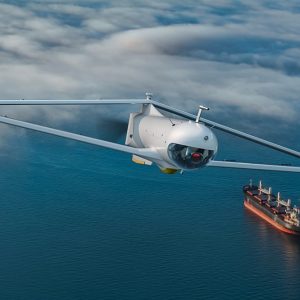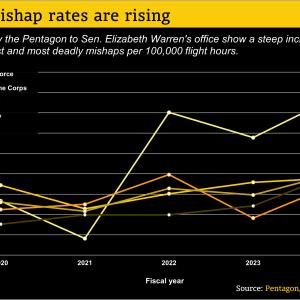
Lockheed Martin’s AGM-158 XR extreme range cruise missile is moving from concept to reality as the company prepares for flight tests by the fourth quarter of 2026, following its public debut in 2024 as an internally funded project.[1]:contentReference[oaicite:0]{index=0} Positioned as the next evolution of the JASSM family, the XR variant aims to give US and allied air forces a standoff strike option at ranges approaching 2,000km while retaining the stealth, penetration and modularity that made JASSM and LRASM core tools of modern airpower.[2]:contentReference[oaicite:1]{index=1}
Key Facts
- Programme: AGM-158 XR extreme range cruise missile, internally funded by Lockheed Martin as part of the JASSM/LRASM portfolio.[1][2]
- Range: Around 2,000km, roughly double JASSM-ER, enabling deep-strike from outside dense air defences.[1][4]
- Warhead: 1,000lb (≈450kg) class penetrator warhead, consistent with existing JASSM variants.[3][5]
- Platforms: Compatible with current JASSM-capable aircraft such as the F-35, F/A-18 and bomber fleets, but not the F-16 due to size and weight.[1][3]
- Test timeline: First flight tests targeted for Q4 2026, following ground integration and range clearance work.[1]
From JASSM to XR: pushing the standoff envelope
The AGM-158 family began as a stealthy, air-launched cruise missile designed to let strike aircraft hit defended targets from hundreds of kilometres away. Over time, JASSM-ER and LRASM extended that reach and added sophisticated maritime strike options, while leveraging a common production base and guidance architecture.[3]:contentReference[oaicite:2]{index=2} The AGM-158 XR extreme range cruise missile represents the next step in that progression: a stretched airframe, more fuel, and optimised aerodynamics to convert the same basic architecture into a true theatre-scale weapon.
Lockheed first disclosed an “extreme range” evolution of JASSM several years ago, when US Air Force budget documents referenced the AGM-158D JASSM-D / JASSM-XR as a longer-range derivative of JASSM-ER.[4]:contentReference[oaicite:3]{index=3} However, the 2024 unveiling of the AGM-158 XR as a distinct designation, and the 2025 Dubai Airshow update on flight-test plans, signalled that the concept has matured into a concrete product line with visible hardware and customer interest.[1][2]
Importantly, the XR programme has been driven in large part by internal Lockheed Martin investment rather than a traditional government-funded development contract.[1][2] This approach allows the company to move faster, demonstrate capability at its own risk, and then offer a near-ready missile to the US Air Force and allied customers who face an urgent requirement for survivable deep-strike options in contested theatres.
Engineering for extreme range and survivability
Range, payload and airframe changes
At the heart of the design is an elongated fuselage that carries significantly more fuel while preserving the missile’s low-observable cross-section and familiar planform. Public reporting places the XR’s reach at around 2,000km, roughly double that of the in-service JASSM-ER and significantly beyond the original AGM-158A baseline.[1][4] The result is a weapon that allows bombers and fighters to launch from well outside the densest layers of modern integrated air defence systems.
The AGM-158 XR extreme range cruise missile retains a 1,000lb class penetrating warhead, mirroring the lethality of earlier JASSM variants rather than trading payload away for additional range.[3][5]:contentReference[oaicite:4]{index=4} This continuity simplifies mission planning and target sets: operators can assume broadly similar effects on hardened or high-value targets, while the extended reach changes where aircraft need to be to deliver those effects.
Structurally, open-source analysis points to refinements in aerodynamics, potential use of lighter alloys, and revised control surfaces to maintain manoeuvrability despite the longer airframe.[5]:contentReference[oaicite:5]{index=5} While detailed performance data remains classified, the design philosophy is clear: squeeze additional kinematic performance out of a proven missile body without demanding new launch platforms, engines or guidance architectures.
Platform integration and commonality
Lockheed emphasises that XR will be compatible with “all platforms that already carry JASSM,” with the notable exception of the F-16, which cannot accommodate the missile’s increased size and mass.[1][3] In practice, that means the F-35, F/A-18, F-15E and US bomber fleets, as well as aircraft configured for palletised cruise-missile launch concepts such as Rapid Dragon. This continuity reduces integration cost and risk for air forces that have already invested in JASSM infrastructure.
Commonality also extends to guidance and mission systems. The XR is expected to leverage the same core navigation suite—combining GPS, INS and imaging infrared terminal guidance—as later-block JASSM and LRASM missiles.[3][4] This reduces certification burdens, preserves interoperability with existing mission-planning tools, and allows incremental software upgrades to propagate across the wider JASSM/LRASM portfolio.
Because much of the qualification and software environment remains the same, Lockheed executives describe the programme as a “stretch” of an already mature system rather than a clean-sheet design. That distinction matters in an environment where munitions production lines are already under pressure; the XR can, in principle, flow through the same industrial base with targeted modifications instead of requiring a parallel factory footprint.[2][8]:contentReference[oaicite:6]{index=6}
Operational logic: Indo-Pacific and beyond
The driving operational logic behind the AGM-158 XR extreme range cruise missile lies in the geography of future conflict, especially in the Indo-Pacific. Chinese anti-access/area-denial (A2/AD) networks, built around long-range surface-to-air missiles, over-the-horizon sensors and anti-ship ballistic missiles, push US and allied aircraft ever further from key targets.[5][6]:contentReference[oaicite:7]{index=7} Extreme-range, low-observable cruise missiles offer one of the few scalable ways to re-extend the reach of manned aircraft without flying them deep into those threat rings.
With a strike radius around 2,000km, bombers or F-35s carrying XR can launch from dispersal bases or maritime platforms that remain outside many high-end SAM envelopes, yet still reach airfields, C2 nodes, logistic hubs and maritime targets deep inside contested zones. This geometry supports emerging distributed operations concepts, where survivability comes from mobility, dispersion and long-range weapons rather than large, fixed main operating bases.
Moreover, the common JASSM/LRASM lineage means operators could combine AGM-158 XR salvos with existing anti-ship and land-attack variants to saturate enemy defences from multiple axes. In a Western Pacific scenario, for example, land-attack XR shots against fixed infrastructure could be paired with LRASM waves targeting surface combatants and logistics vessels, all using similar launch platforms and planning tools.[2][5]
Industrial and programme outlook
Industry reporting suggests that Lockheed Martin is already scaling JASSM and LRASM production, with ambitions to reach annual outputs of around 1,000 missiles across the family.[3][8] Against that backdrop, the AGM-158 XR extreme range cruise missile offers a way to add distinct capability without fragmenting the portfolio. Many components, test processes and supply-chain elements can be shared, which is critical at a time when Western stockpiles have been heavily drawn down by ongoing conflicts.
For the US Air Force, the XR’s path to adoption will likely hinge on balancing near-term munitions replenishment against investment in next-generation deep-strike systems such as hypersonic weapons. Cruise missiles like XR are slower but far more affordable and easier to integrate at scale, making them attractive for sustained campaigns rather than niche, first-night scenarios. If early flight tests in 2026 validate performance claims, procurement decisions could follow relatively quickly, building on earlier AGM-158D planning lines.[4]
Implications for allies and partners
US allies that already operate JASSM—such as Australia, Poland and Finland—are obvious candidates to watch. For them, the AGM-158 XR extreme range cruise missile would represent an incremental step up from current inventories rather than a wholesale shift to a new weapon system.[3] In Indo-Pacific contexts, XR-armed F-35s could give smaller air forces credible reach against critical infrastructure and naval forces without relying solely on US bomber presence.
At the same time, the emergence of XR will not occur in a vacuum. Long-range strike developments on the Chinese and Russian side, along with European debates over deep-strike sovereignty, mean that extreme-range air-launched weapons are becoming a central axis of strategic competition. For NATO planners, XR sits alongside land-based missiles, UCAVs and space-enabled targeting as part of a wider ecosystem of tools for penetrating heavily defended airspace. For more on how this competition is unfolding on the ballistic side, see Defence Agenda’s analysis of China’s DF-5C ICBM modernisation and nuclear signalling.[6]:contentReference[oaicite:8]{index=8}
Conclusion: a defining test for long-range strike
The AGM-158 XR extreme range cruise missile encapsulates several converging trends in contemporary airpower: modular weapon families, industry-funded innovation, and an urgent shift toward very long-range conventional strike. If flight tests in 2026 confirm the promised performance envelope, XR will give commanders a flexible tool for shaping contested theatres without placing crews inside the densest threat rings.
For defence planners and industry alike, the message is clear. Cruise missiles remain a central pillar of long-range strike, even as hypersonic systems capture headlines. The AGM-158 XR extreme range cruise missile is less about revolutionary physics and more about disciplined engineering choices that extract every kilometre of range from a proven design. In an era of stretched industrial capacity and rising demand, that pragmatism may be exactly what Western air forces need.
Further Reading
- Breaking Defense – analysis of Lockheed Martin’s unveiling of the extreme range JASSM variant and its funding model.[2]
- The War Zone – technical breakdown of the AGM-158 XR’s design evolution and potential role against A2/AD architectures.[5]
- Air & Space Forces Magazine – background on USAF planning for the AGM-158D / JASSM-XR procurement line.[4]
- Defence Agenda – “China’s DF-5C nuclear ICBM and the new era of long-range deterrence,” for broader context on deep-strike competition.[6]
References
- [1] Shephard Media, “Dubai Airshow 2025: Lockheed’s AGM-158 XR flight tests planned for 2026,” 19 November 2025. Link
- [2] Breaking Defense, “Lockheed announces new ‘extreme range’ version of JASSM cruise missile,” 16 September 2024. Link
- [3] Wikipedia, “AGM-158 JASSM,” section on AGM-158D JASSM-D / AGM-158 XR, accessed November 2025. Link
- [4] Air & Space Forces Magazine, “USAF to Start Buying ‘Extreme Range’ JASSMs in 2021,” 14 February 2020. Link
- [5] The War Zone, “Everything We Just Learned About The Supersized AGM-158 XR Stealth Cruise Missile,” 16 September 2024. Link
- [6] Defence Agenda, “DF-5C nuclear ICBM and the shifting geometry of long-range deterrence,” accessed November 2025. Link
- [8] The Defense Post, “Lockheed Awarded Multi-Billion JASSM/LRASM Missile Contract by US,” 1 October 2024. Link












